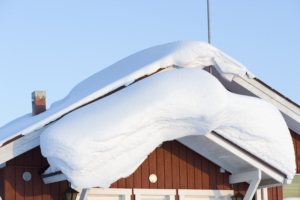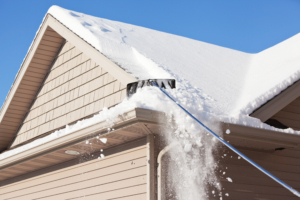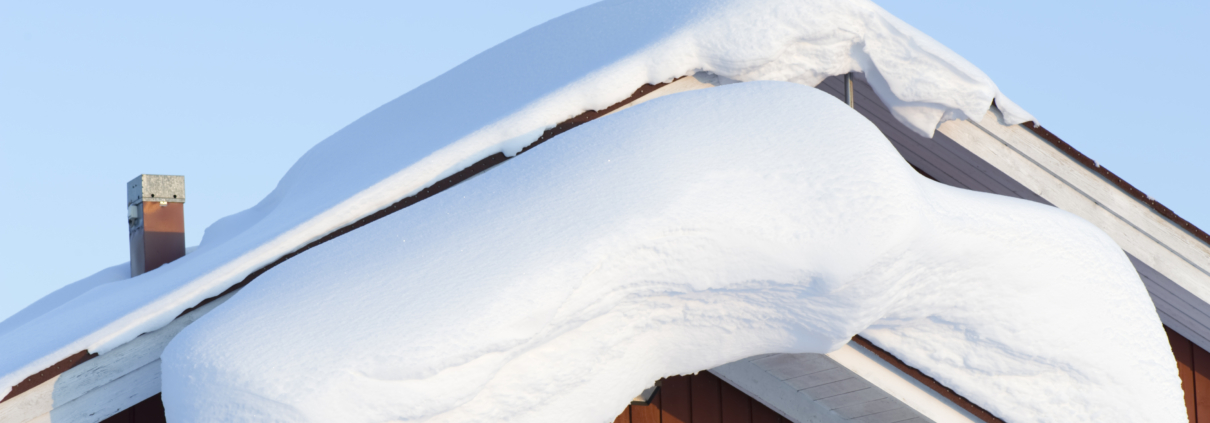How Much Snow Can Your Roof Hold?
Snowfall may be magical, but a roof covered in a large amount of snow can cause costly and dangerous damage to the roof and even result in collapse. Luckily, the majority of roofs are capable of sustaining the load of a bit of snow. Frankly speaking, most residential and commercial roofs are designed with the aim of holding up under the weight of a substantial amount of snow. An average roof will hold up to 20 pounds of snow per square foot. This is roughly equivalent to two feet of wet snow or up to four feet of light, fluffy snow.
The problem arises when the snow load becomes heavier. No doubt, several factors decide how much snow a roof can hold. These may be the shape and composition of your roof or the types of snow. Folks with steep-pitch roofs won’t experience this problem, but those with flat roofs may need to get their roofs cleared regularly to prevent collapse. If you are still unaware of how much snow your roof can hold, as well as want to know about the warning signs of too much snow on the roof and tips for removing them, don’t worry. In this article, we will discuss everything you need to know in case your roof is overloaded with snow.

Benefits of a Snow Covered Roof
Many homeowners become worried at the sight of snow piled up on their roof—but this is actually a good sign! If the snow is quickly melting, this could be an indicator that heat from your home is escaping through the attic floors and then transferring from your roof to the exterior.
Snow that hasn’t yet begun to melt may act as an insulative blanket on your roof. A light, fluffy snow is made up of ice crystals suspended in pockets of air—that’s the same composition of fiberglass insulation, except glass instead of ice. With this make up, it is likely that snow does help retain some of the heat within your home—but of course, you should really rely on your home’s insulation for this!
Normally we wouldn’t expect heat transfer to be such an issue, but the problem is that the heat doesn’t exactly transfer evenly through the roof. The heat rises to the peak of the roof while the edges down near your gutters are much colder. This difference in temperatures can result in snow melting at the higher areas and freezing into ice at the lower edges of the roof. This creates a condition known as ice damming . These dams of ice can lead to leaks and significant roof damage.
RELATED ARTICLE: What Is Ice Damming?
Factors Deciding a Roof’s Capacity to Hold Snow
The local building codes dictate the maximum snow load on a roof required for any residential building. So, it is important for you to contact the local building department to know the snow load requirements for your locality. Fortunately, most roofs are capable of withstanding 20 lbs per square foot of snow before becoming stressed. However, there are several factors at play when deciding the maximum snow load on a roof. Let’s take a look at the factors deciding a roof’s capacity to hold snow.
- Your Roof’s Shape
The shape of your roof plays an important role in shedding snow. Angular roofs are much more efficient in shedding a load of snow than flat roofs because of the gravitational forces. So, homeowners with steeper roofs do not need to pay as much attention to the snow accumulation.
- Your Roof’s Shingles
If your roof shingles are in poor condition, they might have a tough time withstanding the weight of the accumulated snow. For this reason, it is always important for you to examine your roof before the first snowfall of the season. In case you find any defective roof shingles, contact a professional roofing contractor to replace them with a new ones. The amount of layers of shingles on your roof will also impact the amount of snow the roof can hold. A roof with 2 or more layers of shingles will undergo a greater strain.
- Type of Snow
There is no doubt that snow can vary in weight. Wet and packed snow always weighs more than light and powdery fresh snow. As mentioned earlier, most residential roofing can hold 20-30 lbs of snow per square foot. However, the situation can worsen when a snowstorm drops more than 24 inches of snow followed by rainfall.
Warning Signs of Too Much Snow on Your Roof
- Sagging Roof
It is common to witness a sagging roof when it is overloaded with snow. This can often be seen on the ceilings or rafters of your home, either from the inside or outside of your home. For this reason its important to head up to your attic to evaluate the roof structure and ensure no snow has entered. Sometimes, snow from your roof can get sucked in by the roof’s ventilation. A dusting of snow inside your attic is normal, but if you find drifts of snow, it could collapse the drywall ceilings below when it melts.
- Cracks in New Drywall or Plaster
If you see any new cracks in walls around interior door frames, this could be a sign that your roof is overloaded with snow. No doubt, snow on the roof can cause structural problems and framing issues with your house, such as difficulty closing doors normally.
- Leaks in Ceilings
Any leaks in the ceilings after a blizzard or heavy snowfall can indicate having too much snow on your roof, escalating the risk of collapsing the roof. So, It is always important to spend some time inspecting your home’s ceiling after a heavy snowfall to ensure that there aren’t overloads of snow.
Tips for Removing Snow from Your Roof
You will need to judge when is an appropriate time to remove accumulated snow from your roof. Still, you can’t exactly get on top of your roof with a snow shovel. If you have an asphalt roof, you run the risk of doing serious damage to your shingles, which can cause your roof to leak afterwards—and all kinds of havoc as a consequence.
Instead, hire a roofing contractor to safely handle the removal for you. It generally only costs about $100 to $500, and it will save your roof a lot of wear and tear. If the roofers in your area are all booked up, you can do some of the work yourself using a special tool called a roof rake. This long-armed instrument looks sort of like a window squeegee you’d find at a carwash, except it has an aluminum blade with a set of rolling wheels on each end to keep it from damaging your roof. The following tips will help you remove snow and ice from your roof.
- Always use a telescopic rake to clean the snow off the roof
- Remove snow and icicles from the edges of the roof
- Don’t try to remove all the snow, as it can damage your roof’s shingles
- Make sure there is no snow on your attic space

Final Thoughts
We hope now you have a sound knowledge of how much snow a roof can hold, warning signs of too much snow on the roof, and tips for removing them. One thing you should always remember is while cleaning the snow from your roof on your own, do not damage the roofing material. There is no need to manually remove all the snow.




